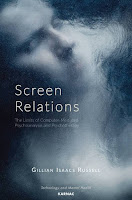Buy Screen Relations here. - Free delivery worldwide
Increased worldwide mobility and easy access to technology means that the use of technological mediation for treatment is being adopted rapidly and uncritically by psychoanalysts and psychoanalytic psychotherapists. Despite claims of functional equivalence between mediated and co-present treatments, there is scant research evidence to advance these assertions.
Can an effective therapeutic process occur without physical co-presence? What happens to screen-bound treatment when, as a patient said, there is no potential to “kiss or kick?” Our most intimate relationships, including that of analyst and patient, rely on a significant implicit non-verbal component carrying equal or possibly more weight than the explicit verbal component. How is this finely-nuanced interchange affected by technologically-mediated communication?
This book draws on the fields of neuroscience, communication studies, infant observation, cognitive science and human/computer interaction to explore these questions. It finds common ground where these disparate disciplines intersect with psychoanalysis in their definitions of a sense of presence, upon which the sense of self and the experience of the other depends. This new data reveals surprising and non-intuitive elements, providing a rich knowledge base for better understanding how people experience screen relations based treatments.
Embedded throughout the book are the movingly clear voices of clinicians and patients themselves, describing their experiences using technology for treatment. Gillian Isaacs Russell, whose own clinical experience using technological mediation inspired her exploration of therapy on the digital frontier, pays particular attention to the specific gains and losses of mediated communication of which clinicians should be aware before undertaking technologically-mediated psychoanalysis or psychotherapy.
Buy Screen Relations here. - Free delivery worldwide




